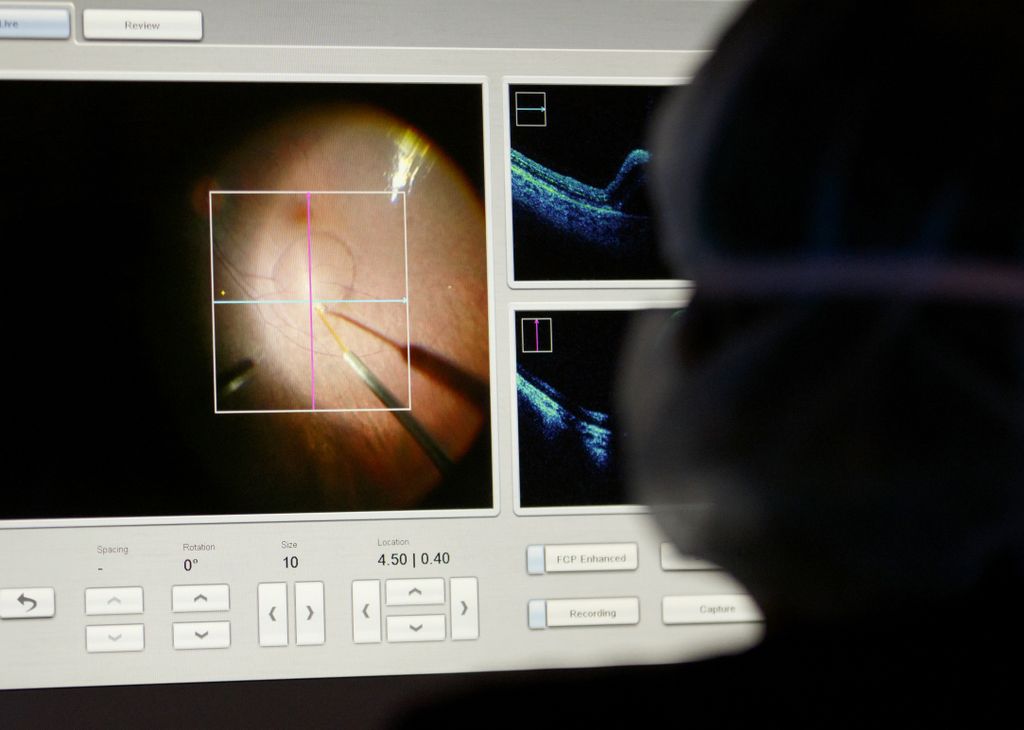A collaborative team of researchers with Oregon Health & Science University and Oregon State University have developed an approach that uses lipid nanoparticles — tiny, lab-made balls of fat — to deliver strands of messenger ribonucleic acid, or mRNA, inside the eye. To treat blindness, the mRNA will be designed to create proteins that edit vision-harming gene mutations.
In a study published today in Science Advances, the team demonstrates how its lipid nanoparticle delivery system targets light-sensitive cells in the eye, called photoreceptors, in both mice and nonhuman primates. The system’s nanoparticles are coated with a peptide that the researchers identified as being attracted to photoreceptors.
“Our peptide is like a zip code, and the lipid nanoparticles are similar to an envelope that sends gene therapy in the mail,” explained the study’s corresponding author, Gaurav Sahay, Ph.D., an associate professor in the OSU College of Pharmacy who also has a joint research appointment at the OHSU Casey Eye Institute. “The peptide ensures mRNA is precisely delivered to photoreceptors — cells that we haven’t been able to target with lipid nanoparticles until now.”
“More than 250 genetic mutations have been linked to inherited retinal diseases, but only one has an approved gene therapy,” added study co-author Renee Ryals, Ph.D., an assistant professor of ophthalmology in the OHSU School of Medicine and a scientist at the OHSU Casey Eye Institute. “Improving the technologies used for gene therapy can provide more treatment options to prevent blindness. Our study’s findings show that lipid nanoparticles could help us do just that.”
Since you’re here...we have a small favor to ask. Retina Global is a nonprofit, and we have to depend on your support to sustain the work we do. Hence the need to ask for your help. Retina Global's work is important, since it not only provides help to disadvantaged people, but also provides resources for developing new treatments that can potentially cure blindness. What we do takes a lot of time, money and hard work. But we do it because we believe we have to help stop someone somewhere from going blind. So make a difference. Click here to donate. Your support is much appreciated. Thank you!
In 2017, the Food and Drug Administration approved the first gene therapy to treat an inherited form of blindness. Many patients have experienced improved vision and have been spared blindness after receiving the therapy, which is sold under the brand name Luxturna. It uses a modified version of the adeno-associated virus, or AAV, to deliver gene-revising molecules.
Today’s gene therapies largely rely on AAV, but it has some limitations. The virus is relatively small and can’t physically contain gene-editing machinery for some complex mutations. And AAV-based gene therapy can only deliver DNA, which results in the continual creation of gene-editing molecules that may lead to unintended genetic edits.
Lipid nanoparticles are a promising alternative because they don’t have size constraints like AAV. Additionally, lipid nanoparticles can deliver mRNA, which only keeps gene-editing machinery active for a short period of time, so could prevent off-target edits. The potential of lipid nanoparticles was further proved by the success of mRNA-based COVID-19 vaccines, which also use lipid nanoparticles to deliver mRNA. They also were the first vaccines to be authorized for COVID-19 in the United States, thanks to the speed and volume at which they could be manufactured.
In this study, Sahay, Ryals and colleagues demonstrated that a peptide-covered lipid nanoparticle shell can be directed toward photoreceptor cells in the retina, tissue in the back of the eye that enables sight. As a first proof of concept, mRNA with instructions to make green fluorescent protein was placed inside nanoparticles.
After injecting this nanoparticle-based gene therapy model into the eyes of mice and nonhuman primates, the research team used a variety of imaging techniques to examine the treated eyes. The animals’ retinal tissue glowed green, illustrating that the lipid nanoparticle shell reached photoreceptors and that the mRNA it delivered successfully entered the retina and created green fluorescent protein. This research marks the first time that lipid nanoparticles are known to have targeted photoreceptors in a nonhuman primate.
The scientists are currently working on follow-up research to quantify how much of the green fluorescent protein is expressed in animal retinal models. They’re also working to develop a therapy with mRNA that carries the code for gene-editing molecules.
Sahay and Ryals will continue developing their nanoparticle gene therapy delivery system with the support of a new, $3.1-million grant from the National Eye Institute of the National Institutes of Health.
This research was supported by the National Eye Institute, Oregon National Primate Research Center, the PhRMA Predoctoral Drug Delivery Fellowship, National Institutes of Health’s Office of Research Infrastructure Programs and Research to Prevent Blindness.
If you wish to read the paper in Science Advances, click here.
More about Retina Global here. We seek your support. Click here to donate.

No comments:
Post a Comment
Thanks for your comments. We will get back to you shortly if there is a need to respond to it.
- Admin, Retina Global
Read more on Retina Global.